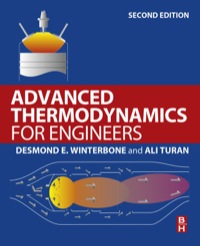The engine designed by Lenoir was essentially an atmospheric engine based on the early steam engines. In
Question:
The engine designed by Lenoir was essentially an atmospheric engine based on the early steam engines. In this, a combustible mixture was contained in a cylinder: it was ignited and the pressure increased isochorically to the maximum level. After this the gas expanded isentropically through an expansion ratio, \(r_{\mathrm{e}}\), during which it produced work output. The air-standard cycle returned the gas to state 1 through an isochoric expansion to \(p_{1}\) and an isobaric compression to \(V_{1}\).
Assume \(p_{1}=1\) bar, \(T_{1}=15{ }^{\circ} \mathrm{C}, p_{2}=10\) bar and the expansion ratio, \(r_{\mathrm{e}}=5\). Calculate the specific work output and thermal efficiency of this cycle. How does this compare with the efficiency of an equivalent Carnot cycle?
\([650.30 \mathrm{~kJ} / \mathrm{kg} ; 34.97 \% ; 90.0 \%]\)
Step by Step Answer:

Advanced Thermodynamics For Engineers
ISBN: 9780080999838
2nd Edition
Authors: D. E. Winterbone, Ali Turan





